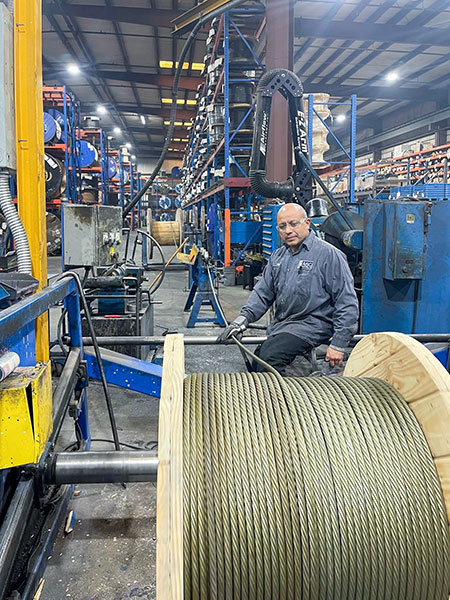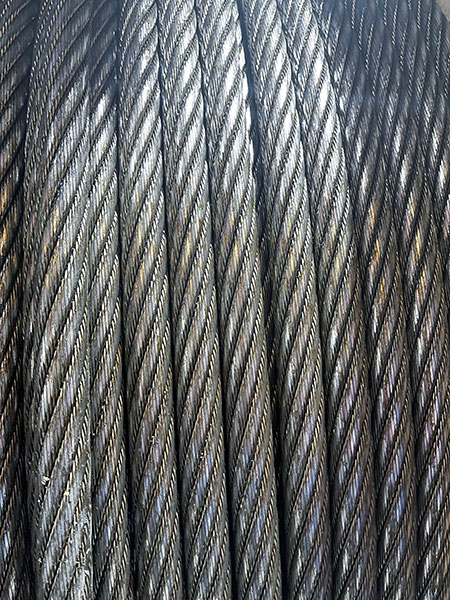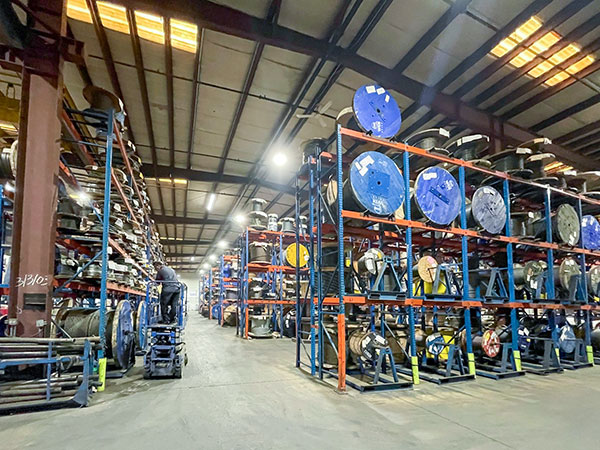

Following are the most common characteristics to be considered when selecting a rope for an application. Wire rope strength is usually measured in tons of 2,000 lbs. In published material, wire rope strength is shown as minimum breaking force or nominal strength. When tested under tension on a device, a new rope should break at a figure equal higher than – the minimum breaking force shown for that rope. The published values apply to new, unused rope. During its useful life, a rope loses strength gradually due to natural causes such as surface wear and metal fatigue. Fatigue resistance involves metal fatigue of the wires that make up a rope. To have high fatigue resistance, wires must be capable of bending repeatedly under stress. Increased fatigue resistance is achieved in a rope design by using a large number of wires. In general, a rope made of many wires will have greater fatigue resistance than a same-size rope made of fewer larger wires because smaller wires have greater ability to bend as the rope passes over sheaves or around drums. Crushing is the effect of external pressure on a rope, which damages it by distorting the cross-section shape of the rope, its strands or core – or all three. Crushing resistance therefore is a rope’s ability to withstand or resist external forces, and is a term generally used to express comparison between ropes. IWRC ropes are more crush resistant than fiber core ropes. Regular lay ropes are more crush resistant than lang lay ropes. Six strand ropes have greater crush resistance than 8 strand ropes or 19 strand ropes. Metal loss refers to the actual wearing away of metal from the outer wires of a rope, and metal deformation is the changing of the shape of outer wires of a rope. In general, resistance to metal loss by abrasion (usually called “abrasion resistance”) refers to a rope’s ability to withstand metal being worn away along its exterior. This reduces strength of a rope. The most common form of metal deformation is generally called “peening” – since outside wires of a peened rope appear to have been “hammered” along their exposed surface. Peening causes metal fatigue, which in turn may cause wire failure.The out-of-round shape also impairs wire movement when the rope bends.
When a load is placed on a rope, torque is created within the rope as wires and strands try to straighten out. This is normal and the rope is designed to operate with this load induced torque. However, this torque can cause loads to rotate. Load-induced torque can be reduced by specially designed rotation resistant ropes. In standard 6 and 8 strand ropes, the torques produced by the outer strands and the IWRC is in the same direction and add together. In rotation resistant ropes, the lay of the outer strands is in the opposite direction to the lay of the inner strands, thus the torques produced are in opposite directions and the torques subtract from each other. Depending upon your application, other wire rope characteristics such as stability, bend ability or reserve strength may need to be considered. The design factor is defined as the ratio of the minimum breaking force of a wire rope to the total load it is expected to carry. Use of design factors provides rope installations with reasonable assurance of adequate capacity for the work to be done throughout a rope’s service life. Considerations in establishing design factors include the type of service (operating speed, rough treatment, sudden loading changes, for example), design of equipment and consequences of failure. In most applications, the selection of a rope based on the proper design factor has been made by the equipment manufacturer. In an application where a different rope is to be used, or in a new application, check government and industry regulations for the required design factor. Different rope types on the same application may have different design factor requirements. Wire Rope is an elastic member, it stretches or elongates under load. This stretch derives from elastic and constructional. When a load is applied to wire rope, the helically-laid wires and strands act in a constricting manner thereby compressing the core and bringing all the rope elements into closer contact. The result is a slight reduction in diameter and an accompanying lengthening of the rope. Ropes with wire strand core (WSC) or independent wire rope core (IWRC) have less constructional stretch than those with fiber core (FC). The reason for this is the fact that the steel cannot compress as much as the fiber core.

Email: info@ascindustries.com
Phone: 708-647-4900